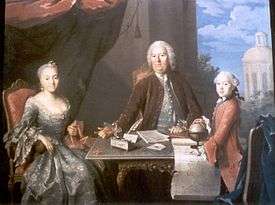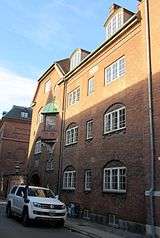Abraham Pelt
Abraham Pelt (11 February 1695 - 14 April 1783) was a Danish industrialist and philanthropist.
Abraham Pelt | |
|---|---|
 Pelt with his wife and son painted by Johan Hörner in the 1750s | |
| Born | 11 February 1695 |
| Died | 14 April 1783 (aged 88) |
| Nationality | Danish |
| Occupation | Sugar manufacturer |
History
Pelt was born in Copenhagen, the son of Hans Peter Pelt (died 1715) and Dorothea Kellinghusen (died 1732). In 1708, his father, who was originally from the Netherlands, obtained a license to establish Copenhagen's second sugar refinery. The sugar refineries were generally the most successful industrial enterprises in the country at the time.[1] Pelt inherited a thriving sugar refinery business. It was originally located in Christianshavn but moved to Gammeltorv after the Copenhagen Fire of 1728. Pelt was active in the Danish Asiatic Company and served as a bank commissioner at Kurantbanken in 1759-74.[2]
Personal life
On 18 November 1743, Pelt married Maria Elisabeth Mushardt (13 3 May 1725 In Kristiania – 1 2 February 1760 in Copenhagen) in Church of Our Saviour. She was a daughter of later Major-General Christian Eberhardt M (died 1732). They had one child, a son, Peter Pelt, who died in 1770. Abraham Pelt died in 1783. He is buried in St. Peter's Church. The sugar refinery, which had by then moved to a site next to the Exchange Dock, was taken over by Pelt's associated Hinrich Ladiges (1731-1805). He was also the owner of a sugar refinery in Naboløs.[3]
Pelts Stiftelse

In 1779, having no longer any living heirs, Pelt established a home for 16 elderly men and women, Pelts Plejestiftelse (or Den Peltske Stiftelse), which was located in Larslejsstræde, adjacent to two similar institutions. One had been operated by St. peter's Church while the other, Thymes Stiftelse, had been established by Winand Thyme in 1775. They were later merged under the name Skt. Petri kirkes, Thymes og Pelts plejestiftelse. It was destroyed in the British bombardment of Copenhagen in 1807 but a new and larger building was completed after the war.[4]
A new building (Larslejsstræde 7) was built in 1899 to design by the architect Frederik Lecy. It was built as part of a larger complex which also comprised new precises for the Herman congregation's Sankt Petri Schule. The new building contained 38 one-room apartments as well as various residences for people associated with the school, congregation or church. Most of the residents were German expatriate women. In 1997, the building was sold to the school which needed more space for its increasing number of students.[5]
References
- "Kjøbenhavn under Frederik den Femte" (in Danish). eremit.dk. Retrieved 3 October 2016.
- "Abraham Pelt" (in Danish). Dansk Biografisk Leksikon. Retrieved 3 October 2016.
- "Gammel Torv 14" (in Danish). pisserenden.com. Retrieved 3 October 2016.
- "Larslejsstræde" (in Danish). pisserenden.com. Retrieved 3 October 2016.
- "Stiftsbygningen i Larslejsstræde 7" (in Danish). Sankt Petri Schule. Retrieved 3 October 2016.